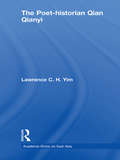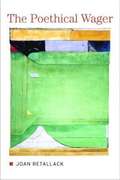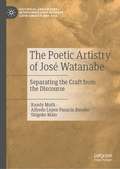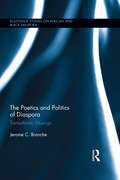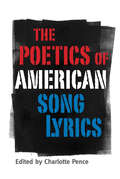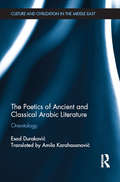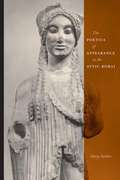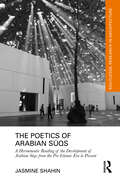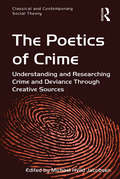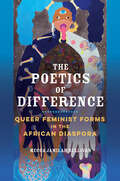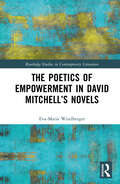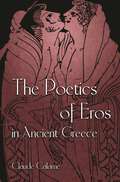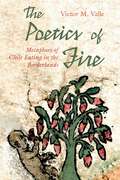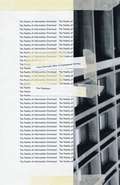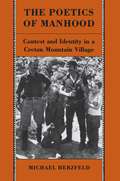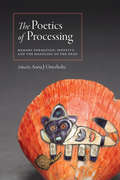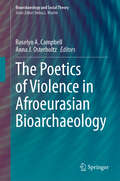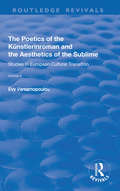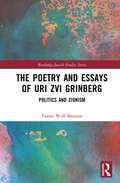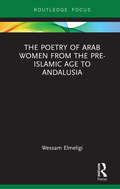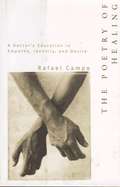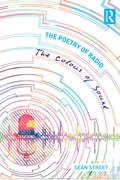- Table View
- List View
The Poet-historian Qian Qianyi (Academia Sinica on East Asia)
by Lawrence C.H YimThis book is the first English language study of Qian Qianyi (1582-1664) - a poet and literary critic during the Ming-Qing dynastic transition. Although Qian’s works constitute some of the greatest achievements in pre-modern Chinese lyric poetry, they have been largely understudied and are poorly understood. Qian was reputed for his own aesthetic that changed the character of late Ming and early Qing poetry. His name, however, was branded with infamy for his disloyalty to the Ming dynasty when it dissolved. Consequently, his works were censored by the Qing court and have been forgotten by most critics until recently. Lawrence C.H Yim focuses on Qian’s poetic theory and practice, providing a critical study of Qian’s theory of poetic-history (shishi) and a group of poems from the Toubi ji. He also examines the role played by history in early Qing verse, rethinking the nature of loyalism and historical memory in seventeenth-century China. Poetry of the Ming-Qing transition is distinguished by its manifest historical consciousness and the effort and give meaning to current historical events, an effort characterized by the pathos of introspection and mourning for the past..This pathos translates into what can be called a poetics of Ming loyalism, exemplified and championed by, intriguingly, the later works of Qian Qianyi himself.
The Poethical Wager
by Joan RetallackIn these inventive essays, Joan Retallack conveys her unique post-utopian vision as she explores the relationship between art and life in today's chaotic world. In the tradition of the essay as complex humanist exploration, she engages ideas from across history: Aristotle's definition of happiness, Epicurus's swerve into unpredictable possibility, Montaigne's essays as an instrument of self-invention, John Cage's redefinition of Silence.
The Poetic Artistry of José Watanabe: Separating the Craft from the Discourse (Historical and Cultural Interconnections between Latin America and Asia)
by Randy Muth Alfredo López-Pasarín Basabe Shigeko MatoConnecting multiple academic areas, this book addresses three aspects of the poetry of José Watanabe: 1) the construction of "Japaneseness" in the poetic works and public figure of the poet, 2) the skillful manipulation of literary devices characteristic of his poetry, 3) the unique sensibilities and moods of ephemerality and ineffableness prevalent in his poetic works. The trans/interdisciplinary nature of the book intends to promote a dialogue and exchange of ideas across academic fields neglected in most studies on the Peruvian poet. Written by researchers based in Japan, it offers a unique perspective of Japanese cultural phenomenon unavailable in previous studies. The goal of the book is to shed light on how Japan continues to be seen by the West through essentialist notions and stereotypical representations, as well as to highlight the fact that the literary quality of Watanabe’s poetic artistry does not reside in it being “Japanese” and can be appreciated without resorting to essentialist categorizations based on positive Japanese stereotypes.
The Poetics and Politics of Diaspora: Transatlantic Musings (Routledge Studies on African and Black Diaspora #7)
by Jerome C. BrancheThis book studies the creative discourse of the modern African diaspora by analyzing poems, novels, essays, hip-hop and dub poetry in the Caribbean, England, Spain, and Colombia, and capturing diasporan movement through mutually intersecting axes of dislocation and relocation, and efforts at political group affirmation and settlement, or “location.” Branche’s study connects London’s multimillion-dollar riots of 2011, and its antecedents associated with the West Indian settler community, to the discontent and harrowing conditions facing black immigrants to contemporary Spain as gateway to Fortress Europe. It links the brutal massacres that target Colombia’s dispossessed and displaced poor - and mainly black - “throwaway” citizens, victims of the drug trade and neoliberal expansionism, to older Caribbean stories that tell of the original spurts of capitalist greed, and the colonial cauldron it created, at the center of which lay the slave trade. In revisiting the question of what really has awaited Afro-descendants at the end of the Middle Passage, this volume brings transatlantic slavery, the making of weak postcolonial states that bleed people, and the needle’s eye of racial identification together through a close reading of rappers, black radicals, dub poetry, and novelists from Europe, Africa, and the Americas. Branche at once demonstrates the existence of an archive of Afro-modern diasporan, discursive production, and just as importantly, points toward a historically-rooted theoretical framework that would contain its liberatory trajectory.
The Poetics and Politics of Youth in Milton's England
by Blaine GretemanAs the notion of government by consent took hold in early modern England, many authors used childhood and maturity to address contentious questions of political representation - about who has a voice and who can speak on his or her own behalf. For John Milton, Ben Jonson, William Prynne, Thomas Hobbes, and others, the period between infancy and adulthood became a site of intense scrutiny, especially as they examined the role of a literary education in turning children into political actors. Drawing on new archival evidence, Blaine Greteman argues that coming of age in the seventeenth century was a uniquely political act. His study makes a compelling case for understanding childhood as a decisive factor in debates over consent, autonomy, and political voice, and will offer graduate students and scholars a new perspective on the emergence of apolitical children's literature in the eighteenth century.
The Poetics of American Song Lyrics (American Made Music Series)
by Charlotte PenceThe Poetics of American Song Lyrics is the first collection of academic essays that regards songs as literature and that identifies intersections between the literary histories of poems and songs. The essays by well-known poets and scholars including Pulitzer Prize winner Claudia Emerson, Peter Guralnick, Adam Bradley, David Kirby, Kevin Young, and many others, locate points of synthesis and separation so as to better understand both genres and their crafts. The essayists share a desire to write on lyrics in a way that moves beyond sociological, historical, and autobiographical approaches and explicates songs in relation to poetics. Unique to this volume, the essays focus not on a single genre but on folk, rap, hip hop, country, rock, indie, soul, and blues. The first section of the book provides a variety of perspectives on the poetic history and techniques within songs and poems, and the second section focuses on a few prominent American songwriters such as Bob Dylan, Bruce Springsteen, and Michael Stipe. Through conversational yet in-depth analyses of songs, the essays discuss sonnet forms, dramatic monologues, Modernism, ballads, blues poems, confessionalism, Language poetry, Keatsian odes, unreliable narrators, personas, poetic sequences, rhythm, rhyme, transcription methods, the writing process, and more. While the strategies of explication differ from essay to essay, the nexus of each piece is an unveiling of the poetic history and poetic techniques within songs.
The Poetics of Ancient and Classical Arabic Literature: Orientology (Culture and Civilization in the Middle East)
by Esad DurakovicThrough analysing ancient and classical Arabic literature, including the Qur'an, from within the Arabic literary tradition, this book provides an original interpretation of poetics, and of other important aspects of Arab culture. <P><P> Ancient Arabic literature is a realm of poetry; prose literary forms emerged rather late, and even then remained in the shadow of poetic creative efforts. Traditionally, this literature has been viewed through a philologist’s lens and has often been represented as ‘materialistic’ in the sense that its poetry lacked imagination. As a result, Arabic poetry was often evaluated negatively in relation to other poetic traditions. The Poetics of Ancient and Classical Arabic Literature argues that old Arabic literature is remarkably coherent in poetical terms and has its own individuality, and that claims of its materialism arise from a failure to grasp the poetic principles of the Arabic tradition. Analysing the Qur’an, which is known for confronting the poetry of the time, this book reveals that "post Qur’anic" literature came to be defined against it. Thus, the constitution and interpretation of Arabic literature imposed itself as a particular exegesis of the sacred Text. <P><P> Disputing traditional interpretations by arguing that Arabic literature can only be assessed from within, and not through comparison with other literary traditions, this book is of interest to students and scholars of Islamic Studies, Arabic Studies and Literary Studies.
The Poetics of Appearance in the Attic Korai
by Mary StieberSome of the loveliest works of Archaic art were the Athenian korai--sculptures of beautiful young women presenting offerings to the goddess Athena that stood on the Acropolis. Sculpted in the sixth and early fifth centuries B. C. , they served as votives until Persians sacked the citadel in 480/79 B. C. Subsequently, they were buried as a group and forgotten for nearly twenty-four centuries, until archaeologists excavated them in the 1880s. Today, they are among the treasures of the Acropolis Museum. Mary Stieber takes a fresh look at the Attic korai in this book. Challenging the longstanding view that the sculptures are generic female images, she persuasively argues that they are instead highly individualized, mimetically realistic representations of Archaic young women, perhaps even portraits of real people. Marshalling a wide array of visual and literary evidence to support her claims, she shows that while the korai lack the naturalism that characterizes later Classical art, they display a wealth and realism of detail that makes it impossible to view them as generic, idealized images. This iconoclastic interpretation of the Attic korai adds a new dimension to our understanding of Archaic art and to the distinction between realism and naturalism in the art of all periods. Some of the loveliest works of Archaic art were the Athenian korai--sculptures of beautiful young women presenting offerings to the goddess Athena that stood on the Acropolis. Sculpted in the sixth and early fifth centuries B. C. , they served as votives until Persians sacked the citadel in 480/79 B. C. Subsequently, they were buried as a group and forgotten for nearly twenty-four centuries, until archaeologists excavated them in the 1880s. Today, they are among the treasures of the Acropolis Museum. Mary Stieber takes a fresh look at the Attic korai in this book. Challenging the longstanding view that the sculptures are generic female images, she persuasively argues that they are instead highly individualized, mimetically realistic representations of Archaic young women, perhaps even portraits of real people. Marshalling a wide array of visual and literary evidence to support her claims, she shows that while the korai lack the naturalism that characterizes later Classical art, they display a wealth and realism of detail that makes it impossible to view them as generic, idealized images. This iconoclastic interpretation of the Attic korai adds a new dimension to our understanding of Archaic art and to the distinction between realism and naturalism in the art of all periods.
The Poetics of Arabian Sūqs: A Hermeneutic Reading of the Development of Arabian Sūqs from the Pre-Islamic Era to Present (Routledge Research in Architecture)
by Jasmine ShahinThis book investigates the history of Arabian sūqs from their pre-Islamic beginnings to the present. Collecting evidence from archaeological ruins, Islamic towns, modern cities, Arabic poetry, philosophical debates, political conflicts, puppet shows and the insights of modern-day market-goers, the book presents new and unforeseen interpretations of the Arabian sūq’s meaning and its transformation through time and place. The finding that such meaning is tied to ancient trade rituals, where temple and market presented a holistic socio-urban unit, re-questions some instrumental assumptions regarding the value of sūq-ness in Arabia’s everyday practices. Such a finding, which locates the fadaā/tareeq duality as a central theme in Arabia’s socio-urban discourse, emphasizes the importance of lived experiences and poetics as key sources for understanding socio-urban phenomena.
The Poetics of Crime: Understanding and Researching Crime and Deviance Through Creative Sources (Classical and Contemporary Social Theory)
by Michael Hviid JacobsenThe Poetics of Crime provides an invitation to reconsider and reimagine how criminological knowledge may be creatively and poetically constructed, obtained, corroborated and applied. Departing from the conventional understanding of criminology as a discipline concerned with refined statistical analyses, survey methods and quantitative measurements, this book shows that criminology can - and indeed should - move beyond such confines to seek sources of insight, information and knowledge in the unexplored corners of poetically and creatively inspired approaches and methodologies. With chapters illustrating the ways in which criminologists and other researchers or practitioners working on crime-related questions can find inspiration in a variety of unconventional materials, writing styles and analytical strategies, The Poetics of Crime offers studies of police photography, classic and contemporary literature, silver screen movies, performative dance enactments and media images. As such, this volume opens up the field of criminological research to alternative and novel sources of knowledge about crime, its perpetrators and victims, authorities, motives and justice. It will therefore appeal not only to sociologists, social theorists and criminologists, but to scholars across disciplines with interests in crime, deviance and innovative approaches to social research.
The Poetics of Cruising: Queer Visual Culture from Whitman to Grindr
by Jack ParlettA groundbreaking new history of urban cruising through the lenses of urban poets The Poetics of Cruising explores the relationship between cruising, photography, and the visual in the work of leading poets, from Walt Whitman in the nineteenth century to Eileen Myles in the twenty-first. What is it that happens, asks Jack Parlett, and what is it that is sought, in this often transient moment of perception we call cruising, this perceptual arena where acts of looking between strangers are intensified and eroticized? Parlett believes that this moment is not only optical in nature but visual: a mode of looking that warrants comparison with the ways in which we behold still and moving images. Whether it&’s Whitman&’s fixation with daguerreotypes, Langston Hughes&’s hybrid photographic works, or Frank O&’Hara&’s love of Hollywood movie stars, argues Parlett, the history of poets cruising abounds with this intermingling between the verbal and the visual, the passing and the fixed. To look at someone in the act of cruising, this history suggests, is to capture, consider, and aestheticize, amid the flux and instantaneity of urban time. But it is also to reveal the ambivalence at the heart of this erotic search, where power may be unevenly distributed across glances, and gendered and racialized bodies are marked. Thus, in identifying for the first time this confluence of cruising, poetry, and visual culture, Parlett concludes that the visual erotic economy associated with gay cruising today, exemplified by the photographic grid of an app like Grindr, is not a uniquely contemporary phenomenon. Innovative, astute, and highly readable, and drawing on compelling archival material, The Poetics of Cruising is a must for scholars of queer and LGBTQ literature and culture, modern and contemporary poetry, visual studies, and the history of sexuality.
The Poetics of Difference: Queer Feminist Forms in the African Diaspora (New Black Studies Series)
by Mecca Jamilah SullivanFrom Audre Lorde, Ntozake Shange, and Bessie Head, to Zanele Muholi, Suzan-Lori Parks, and Missy Elliott, Black women writers and artists across the African Diaspora have developed nuanced and complex creative forms. Mecca Jamilah Sullivan ventures into the unexplored spaces of black women’s queer creative theorizing to learn its languages and read the textures of its forms. Moving beyond fixed notions, Sullivan points to a space of queer imagination where black women invent new languages, spaces, and genres to speak the many names of difference. Black women’s literary cultures have long theorized the complexities surrounding nation and class, the indeterminacy of gender and race, and the multiple meanings of sexuality. Yet their ideas and work remain obscure in the face of indifference from Western scholarship. Innovative and timely, The Poetics of Difference illuminates understudied queer contours of black women’s writing.
The Poetics of Empowerment in David Mitchell’s Novels (Routledge Studies in Contemporary Literature)
by Eva-Maria WindbergerThe Poetics of Empowerment in David Mitchell’s Novels combines the investigation of David Mitchell’s novels with the introduction of a new critical concept to literary studies: empowerment. Aiming to situate and establish empowerment firmly within the context of literary studies, it offers the first framework and definition for reading fictional texts with the lens of empowerment and applies it in the analysis of discourse, the fictional characters, and the role of the reader in Mitchell’s novels. Drawing on narratological analysis, cognitive approaches to literature, and reader-response theory, it features close readings of Cloud Atlas (2004), Black Swan Green (2006), and The Thousand Autumns of Jacob de Zoet (2010) and dissects the author’s strategies, poetics, and agenda of empowering fiction. This book argues for an inherent, indissoluble connection between empowerment and the telling of stories and demonstrates how literary studies can benefit from a serious engagement with empowerment—and how such an engagement can stimulate new responses to fiction and put literary studies in conversation with other disciplines.
The Poetics of Eros in Ancient Greece
by Claude CalameThe Poetics of Eros in Ancient Greece offers the first comprehensive inquiry into the deity of sexual love, a power that permeated daily Greek life. Avoiding Foucault's philosophical paradigm of dominance/submission, Claude Calame uses an anthropological and linguistic approach to re-create indigenous categories of erotic love. He maintains that Eros, the joyful companion of Aphrodite, was a divine figure around which poets constructed a physiology of desire that functioned in specific ways within a network of social relations. Calame begins by showing how poetry and iconography gave a rich variety of expression to the concept of Eros, then delivers a history of the deity's roles within social and political institutions, and concludes with a discussion of an Eros-centered metaphysics. Calame's treatment of archaic and classical Greek institutions reveals Eros at work in initiation rites and celebrations, educational practices, the Dionysiac theater of tragedy and comedy, and in real and imagined spatial settings. For men, Eros functioned particularly in the symposium and the gymnasium, places where men and boys interacted and where future citizens were educated. The household was the setting where girls, brides, and adult wives learned their erotic roles--as such it provides the context for understanding female rites of passage and the problematics of sexuality in conjugal relations. Through analyses of both Greek language and practices, Calame offers a fresh, subtle reading of relations between individuals as well as a quick-paced and fascinating overview of Eros in Greek society at large.
The Poetics of Fire: Metaphors of Chile Eating in the Borderlands (Querencias Series)
by Victor M. ValleIn The Poetics of Fire, Pulitzer prize–winning journalist and Chicano author Victor M. Valle posits the chile as a metaphor for understanding the shared cultural histories of ChicanX and LatinX peoples from preconquest Mesoamerica to twentieth-century New Mexico. Valle uses the chile as a decolonizing lens through which to analyze preconquest Mesoamerican cosmology, early European exploration, and the forced conversion of Native peoples to Catholicism as well as European and Mesoamerican perspectives on food and place. Assembling a rich collection of source material, Valle highlights the fiery fruit&’s overarching importance as evidenced by the ubiquity of references to the plant over several centuries in literature, art, official documents, and more to offer a new eco-aesthetic reading—a reframing of culinary history from a pluralistic, non-Western perspective.
The Poetics of Information Overload: From Gertrude Stein to Conceptual Writing
by Paul StephensInformation overload is a subject of vital, ubiquitous concern in our time. The Poetics of Information Overload reveals a fascinating genealogy of information saturation through the literary lens of American modernism. Although technology has typically been viewed as hostile or foreign to poetry, Paul Stephens outlines a countertradition within twentieth- and twenty-first-century literature in which avant-garde poets are centrally involved with technologies of communication, data storage, and bureaucratic control. Beginning with Gertrude Stein and Bob Brown, Stephens explores how writers have been preoccupied with the effects of new media since the advent of modernism. He continues with the postwar writing of Charles Olson, John Cage, Bern Porter, Hannah Weiner, Bernadette Mayer, Lyn Hejinian, and Bruce Andrews, and concludes with a discussion of conceptual writing produced in the past decade.By reading these works in the context of information systems, Stephens shows how the poetry of the past century has had, as a primary focus, the role of data in human life.
The Poetics of Manhood: Contest and Identity in a Cretan Mountain Village
by Michael HerzfeldThe description for this book, The Poetics of Manhood: Contest and Identity in a Cretan Mountain Village, will be forthcoming.
The Poetics of Military Occupation: Mzeina Allegories of Bedouin Identity Under Israeli and Egyptian Rule
by Smadar LavieThe romantic, nineteenth-century image of the Bedouin as fierce, independent nomads on camelback racing across an endless desert persists in the West. Yet since the era of Ottoman rule, the Mzeina Bedouin of the South Sinai desert have lived under foreign occupation. For the last forty years Bedouin land has been a political football, tossed back and forth between Israel and Egypt at least five times.
The Poetics of Processing: Memory Formation, Identity, and the Handling of the Dead
by Anna J. OsterholtzIn 2002, Neil Whitehead published Dark Shamans: Kanaimà and the Poetics of Violent Death, in which he applied the concept of poetics to the study of violence and observed the power of violence in the creation and expression of identity and social relationships. The Poetics of Processing applies Whitehead’s theory on violence to mortuary and skeletal assemblages in the Andes, Mexico, the US Southwest, Jordan, Ethiopia, Egypt, and Turkey, examining the complex cultural meanings of the manipulation of remains after death. The contributors interpret postmortem treatment of the physical body through a poetics lens, examining body processing as a mechanism for the re-creation of cosmological events and processing’s role in the creation of social memory. They analyze methods of processing and the ways in which the living use the physical body to stratify society and gain power, as evidenced in rituals of body preparation and burial around the world, objects buried with the dead and the hierarchies of tomb occupancy, the dissection of cadavers by medical students, the appropriation of living spaces once occupied by the dead, and the varying treatments of the remains of social outsiders, prisoners of war, and executed persons. The Poetics of Processing combines social theory and bioarchaeology to examine how the living manipulate the bodies of the dead for social purposes. These case studies—ranging from prehistoric to historic and modern and from around the globe—explore this complex material relationship that does not cease with physical death. This volume will be of interest to mortuary archaeologists, bioarchaeologists, and cultural anthropologists. Contributors: Dil Singh Basanti, Roselyn Campbell, Carlina de la Cova, Eric Haanstad, Scott Haddow, Christina Hodge, Christopher Knusel, Kristin Kuckelman, Clark Spencer Larsen, Debra Martin, Kenneth Nystrom, Adrianne Offenbecker, Megan Perry, Marin Pilloud, Beth K. Scaffidi, Mehmet Somel, Kyle D. Waller
The Poetics of Violence in Afroeurasian Bioarchaeology (Bioarchaeology and Social Theory)
by Anna J. Osterholtz Roselyn A. CampbellThis volume explores violence in bioarchaeological case studies from various cultures, geographic regions, and time periods throughout the Eastern Hemisphere through the lens of Neil Whitehead's concept of poetics. It emphasizes the role and power of performance and ritual in violent acts, and how different types of violence are used within societies. Whitehead’s poetics of violence model has primarily been applied to Western Hemisphere assemblages and indigenous groups, and this is the first volume dedicated to the application of this theoretical model to Europe, Asia, and Africa. Developed from a symposium organized at the American Association of Physical Anthropologists annual meeting in 2018, this volume keeps a tight focus on the direct link between physical evidence for violence in human remains and the contextualized interpretations of how that violence may have functioned within an individual’s society. This type of theoretical interpretation, which treats violence as ameaningful act firmly embedded within its cultural context, rather than as an aberration, is rarely applied to archaeological assemblages and human remains from the Eastern Hemisphere. This is the first volume to offer direct physical evidence for how violence was enacted and understood within different societies in the past. This volume aims to make these rigorous theoretical studies available to students and professionals in archaeology, anthropology, and bioarchaeology, and to provide a model for other researchers to interpret evidence of violence in human remains from archaeological contexts.
The Poetics of the Kunstlerinroman and the Aesthetics of the Sublime (Routledge Revivals)
by Evy VarsamopoulouThis title was first published in 2002: This study of the poetics of the Romantic K nstlerinroman (female artist novel) brings to the foreground its salient metafictional discourse on the aesthetics of the sublime, ever since its beginnings in Madame de Sta l's "Corinne ou L'Italie". The book presents detailed readings of H.D.'s "Palimpsest", Christa Wolf's "Nachdenken ber Christa T." and Marguerite Duras' "L'Amant" in a dialogue with Kant, Freud, Lacan, Cixous, Derrida and other philosophers, theorists, literary critics and writers. Each novel is explored in terms of its generic affiliations, its reflections on the role of literature and the writer in society and its aesthetic discourse on the sublime. The book stages an inquiry into the relation between genre, the sublime, gender and literary history from which emerge insights into the conditions of subjectivity underlying the experience and communication of the sublime.
The Poetry and Essays of Uri Zvi Grinberg: Politics and Zionism (ISSN)
by Tamar Wolf-MonzonThis book focuses on the complex network of relationships between the poet Uri Zvi Grinberg and the Labor Movement in Mandate Palestine from 1923 to 1937.Making use of letters found in the Uri Zvi Grinberg Archive at the National Library of Israel (NLI), the author reconstructs the characteristics of Grinberg’s pioneer readership, attesting to their special relationship with his poetry. In the 1920s, it is argued, they considered Grinberg’s poetry an authentic expression of their complex spiritual world and especially of the reality of their lives. On his side, Grinberg accepted the pioneering ethos as the ideological basis of his works, becoming an outstanding poet of the Labor Movement. The chapters of this book track the various phases of Grinberg’s life and poetry, from his emigration to Palestine through to the 1930s, when he joined the Revisionist Movement and became increasingly ostracized from the Labor Movement. The story of Grinberg’s relations with the pioneers was emotionally charged—a mixture of enchantment and rejection, spiritual closeness and repulsion. Ultimately, this book analyzes the intensity of this connection and its many contradictory layers.This book will interest researchers in a range of fields, including Hebrew poetry and reception theory, as well as anyone interested in Israeli studies and the history of the Labor Movement in Palestine.
The Poetry of Arab Women from the Pre-Islamic Age to Andalusia (Focus on Global Gender and Sexuality)
by Wessam ElmeligiThis is a compilation of poetry written by Arabic women poets from pre-Islamic times to the end of the Abbasid caliphate and Andalusia, and offers translations of over 200 poets together with literary commentary on the poets and their poetry. This critical anthology presents the poems of more than 200 Arabic women poets active from the 600s through the 1400s CE. It marks the first appearance in English translation for many of these poems. The volume includes biographical information about the poets, as well as an analysis of the development of women’s poetry in classical Arabic literature that places the women and the poems within their cultural context. The book fills a noticeable void in modern English-language scholarship on Arabic women, and has important implications for the fields of world and Arabic literature as well as gender and women’s studies. The book will be a fascinating and vital text for students and researchers in the fields of Gender Studies and Middle Eastern studies, as well as scholars and students of translation studies, comparative literature, literary theory, gender studies, Arabic literature, and culture and classics.
The Poetry of Healing: A Doctor's Education in Empathy, Identity, and Desire
by Rafael CampoBack Cover: The healing powers of speech, of touch, of empathy and the erotic, of love itself--these are some of the themes of Rafael Campo's deeply humanistic work as he writes not just of his attempts to heal, but of how his patients healed him. From Campo's arresting first chapter, one is in the hands of the writer who bridges the clinical distance of medicine to face the pain of mortality, the brokenness of society, and the unique and vulnerable beauty of human beings. His work, the Los Angeles Times said, is "reminiscent of Chekhov... [in] the way language comes up out of the body."
The Poetry of Radio: The Colour of Sound
by Seán StreetThis book explores the idea of the poetic in radio and sound as well as the concept of pure sound as poetry, both historically and within a contemporary perspective, examining examples of makers and works internationally. The work examines the development of poetic forms in sound broadcasting historically and geographically through chapters taking narrative themes. It includes primary source material gathered through interviews conducted by the author with distinguished producers and poets. Among these are producers Piers Plowright, Matt Thompson, Alan Hall, Simon Elmes and Julian May (UK) Edwin Brys, (Belgium) Hildegard Westerkamp (Germany/Canada) Chris Brookes (Canada) Robyn Ravlitch, Michael Ladd and Kaye Mortley (Australia) as well as poets, including Michael Symmons Roberts and Jeremy Hooker. There is a chapter on the poetic sound in the natural world, which focuses in particular on the work of the renowned UK sound recordist, Chris Watson. Alongside audio poetry, the book discusses the spoken word including documentaries and public announcements, the radio feature, soundscapes, sonic art with contributions from key figures such as Colin Black (Australia) and Marcus Leadley (UK)and the poetry of the vernacular in speech and sound. It considers new platforms for listening including podcasts and developments in mobile technologies, examining the work of current practitioners including Francesca Panetta, who is responsible for The Guardian's podcasts as well as the award-winning Hackney Podcast, and Tim Wright.
